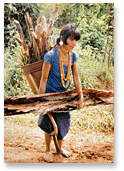Home » Ethnic People » People from the Central Highlands
Vietnam’s Ethnic Minorities
Minorities Of The Central Highlands

Nearly all minority groups living in the central highlands are indigenous peoples: most are matrilineal societies with a strong emphasis on community life and with some particularly complex burial rites. Catholic missionaries enjoyed considerable success in the central highlands, establishing a mission at Kon Tum in the mid-nineteenth century, and then early in the twentieth century Protestantism was also introduced to the region. Most converts came from among the Ede and Bahnar, though other groups have also incorporated Christian practices into their traditional belief systems. Likewise, Vietnamese influence has been stronger here than in northern Vietnam, while the American War caused severe disruption. Nevertheless, their cultures have been sufficiently strong to resist complete assimilation.
Jarai (Or Gia-Rai)
The largest minority group on the central highlands is the Jarai, with a population of roughly 250,000. It’s thought that Jarai people left the coastal plains around 2000 years ago, settling on the fertile plateau around Plei Ku, in Kon Tum Province. Some ethnologists hold that Cham people are in fact a branch of the Jarai, and they certainly share common linguistic traits and a matrilineal social order. Young Jarai women initiate the marriage proposal and afterward the couple live in the wife’s family home, with children taking their mother’s name.
Villages are often named for a nearby river, stream, or tribal chief and in the centre of each can be found a large stilt house nha-rong, which acts as a kind of community centre where the council of elders and their elected chief meet. Houses are traditionally built on stilts, facing north. Jarai women typically propose marriage to men through a matchmaker, who delivers the prospective groom a copper bracelet. Animistic beliefs and rituals still abound and the Jarai pay respect to their ancestors and nature through a host of genies (yang). Popular spirits include the King of Fire (Po Teo Pui) and the King of Water (Po Teo La), whom they summon to bring forth rain. Perhaps more than any of Vietnam s other hill tribes, the Jarai are renowned for their indigenous musical instruments, from stringed ‘gongs’ to bamboo tubes, which act as wind flutes and percussion.
Animist beliefs are still strong and the Jarai world is peopled with spirits, the most famous of which are the kings of Water, Fire, and Wind, represented by shamans who are involved in rain-making ceremonies and other rituals. Funeral rites are particularly complex and expensive: after the burial, a funeral house is built over the grave and evocative sculptures of people, birds, and objects from everyday life are placed inside. The Jarai also has an extensive musical repertoire, the principal instruments being gongs and the unique k’longput, made of bamboo tubes into which the players force air by clapping their hands. During the American War, the majority of Jarai villagers moved out of their war-torn homeland; many have been resettled in Plei Ku, and others are only now slowly returning.
Ede (Or Rhade)
Further south, towards Buon Me Thuot, in Dak Lak Province, around 200,000 people of the polytheist Ede minority live in stilt houses grouped together in a village or buon. These longhouses, which can be up to 100m in length, are beamless, boat-shaped with hardwood frames, bamboo floors, and walls, and topped with a high thatched roof. Families allot about a third of the living space for communal use, with the rest partitioned into smaller quarters to give privacy to married couples. Like the Jarai, the families of Ede girls make proposals of marriage to men, and once wed the couple resides with the wife’s family and children bear the mother’s family name. Inheritance is also reserved solely for women, in particular the youngest daughter of the family. As many as a hundred family members may live in a single house, under the authority of the oldest or most respected woman, who owns all family property, including the house and domestic animals; wealth is indicated by the number of ceremonial gongs. Other much-prized heirlooms are the large earthenware jars used for making the rice wine drunk at festivals. Like the Jarai, Ede people worship the kings of Fire and Water among a whole host of animist spirits and also erect a funeral house on their graves. Both the original longhouse and its grave-site replica are often decorated with fine carvings. The Ede homeland lies in a region of red soils on the rolling western plateaux. In the nineteenth and twentieth centuries, French settlers introduced coffee and rubber estates to the area, often seizing land from the local people they called Rhade. Traditional swidden farming has gradually been disappearing, a process accelerated by the American War and the forced relocation of Ede into permanent settlements.
Sedang (Or Xo-Dang)
According to their oral histories, Sedang people once lived further north but are now concentrated in the area between Kon Tum and Quang Ngai, comprising a community of nearly 100,000. The Sedang was traditionally a war-like people whose villages were surrounded with defensive hedges, barbed with spears and stakes, and with only one entrance. Intervillage wars were frequent and the Sedang also carried out raids on the peaceable Bahnar, mainly to seize prisoners rather than territory. In the past, Sedang religious ritual involved human sacrifices to propitiate the spirits – a practice that was later modified into a profitable business, selling slaves to traders from Laos and Thailand. In the 1880s, an eccentric French military adventurer called Marie-David de Mayrena, established a kingdom in Sedang territory by making treaties with the local chiefs. A few decades later, the French authorities conscripted Sedang labour to build Highway 14 from Kon Tum to Da Nang; conditions were so harsh that many died, provoking a rebellion in the 1930s. Soon after, the Viet Minh won many recruits among the Sedang in their war against the French. In the American War, some Sedang groups fought for the Viet Cong while others were formed into militia units by the American Special Services. But when fighting intensified after 1965, Sedang villagers were forced to flee and many now live in almost destitute conditions, having lost their ancestral lands. Traditionally, membership of a Sedang village was indicated by the use of a common water source. Each extended family occupies a longhouse, built on stilts and usually facing east; central to village life is the communal house where young men and boys sleep, and where all the major ceremonies take place. Because villages historically had relatively little contact with each other, there are marked variations between the social customs of the subgroups and so far seventeen Sedang dialects have been identified. Agricultural techniques are more consistent, mainly swidden farming supplemented by horticulture and hunting. Some Sedang farmers employ a “water harp”, a combined bird-scarer, musical instrument and appeaser of the spirits. The harp consists of bamboo tubes linked together and placed in a flowing stream to produce an irregular, haunting sound.
The Sedang have relations stretching as far as Cambodia. Like many of their neighbours, the Sedang have been adversely affected by centuries of war and outside invasion. They do not carry family names, and there is said to be complete equality between the sexes. The children of one’s siblings are also given the same treatment as one’s own, creating a strong fraternal tradition. Although most Sedang spiritual and cultural ceremonies relate to agriculture, they still practice unique customs such as grave-abandonment and sharing of the property with the deceased, and childbirth is conducted at the forest’s edge.
Mnong
The Mnong ethnic minority is probably best known for its skill in hunting elephants and domesticating them for use in war, for transport and for their ivory. Mnong people are also the creators of the lithophone, a kind of stone xylophone thought to be among the world’s most ancient musical instruments; an example is on show at the Lam Dong Province Museum in Da Lat. The Mnong have lived in the southern central highlands for centuries, and now around 67,000 people are concentrated in the region between Buon Me Thuot and Da Lat. Mnong houses are usually built flat on the ground and, though the society is generally matrilineal, village affairs are organized by a male chief. Mnong craftsmen are skilled at basketry and printing textiles, while they also make the copper, tin and silver jewellery worn by both sexes. In traditional burial rituals, a buffalo-shaped coffin is placed under a funeral house which is peopled with wooden statues and painted with black, red or white designs.
Bru And Ta-Oi
Two related minority groups had the extreme misfortune to live on the Seventeenth Parallel, near the border with Laos: the Bru (or Bnu Van Kieu), these days numbering around 40,000, and the Ta-oi, with a population of only 26,000. Bru people were caught up in the battle of Khe Sanh – both as refugees and as part of an American militia force – while the Ta-oi, amongst others, helped keep open the Ho Chi Minh Trail for the North Vietnamese Army. During the worst years of fighting, refugees fled south to Ede country or crossed over into Laos, and many never returned. Those that did move back found Viet people settled on their best land – the Khe Sanh plateau was declared a New Economic Zone – and were forced into marginal areas. Of the two groups, Bru people have always had greater contact with the outside world since the ancient Lao Bao trade route passes through their territory to Laos. Bru houses can usually be distinguished by their rounded shape, likened to a tortoiseshell, and are occasionally decorated with carved birds or buffalo horns at each end. Both groups are patrilineal, practise swidden farming and worship a huge range of spirits, though ancestor worship is also central to their belief systems.
Cham
As the Viet people pushed down the coastal plain and into the Mekong Delta they displaced two main ethnic groups, the Cham and Khmer. Up until the tenth-century powerful Cham kings had ruled over most of southern Vietnam; nowadays, there are less than 100,000
Cham people, mostly living on the coast between Phan Rang and Phan Thiet, or on the Cambodian border around Chay Doc, with a small number in Ho Chi Minh City. The coastal communities are largely still Hindu worshippers of Shiva and follow the matrilineal practices of their Cham ancestors; they earn a living from farming, silk weaving and crafting jewellery of gold or silver. Groups along the Cambodian border are Islamic and, in general, patrilineal. They engage in river-fishing, weaving and cross-border trade, with little agricultural activity. On the whole, Cham people have adopted the Vietnamese way of life and dress, though their traditional arts, principally dance and music, have experienced a revival in recent years.
Ethnic Khmers are the indigenous people of the Mekong Delta, including Cambodia. Nowadays only about 900,000 remain in the eastern delta under Vietnamese rule, and some of these only arrived in the late 1970s as refugees from Pol Pot’s brutal regime in Cambodia.
With extracts from The Rough Guide to Vietnam by C Jan Dodd

